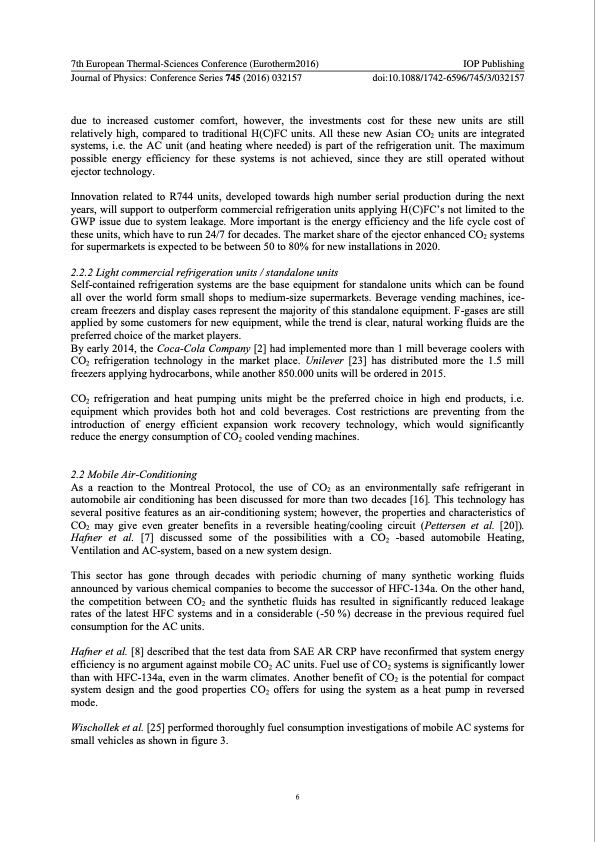
PDF Publication Title:
Text from PDF Page: 007
7th European Thermal-Sciences Conference (Eurotherm2016) IOP Publishing Journal of Physics: Conference Series 745 (2016) 032157 doi:10.1088/1742-6596/745/3/032157 due to increased customer comfort, however, the investments cost for these new units are still relatively high, compared to traditional H(C)FC units. All these new Asian CO2 units are integrated systems, i.e. the AC unit (and heating where needed) is part of the refrigeration unit. The maximum possible energy efficiency for these systems is not achieved, since they are still operated without ejector technology. Innovation related to R744 units, developed towards high number serial production during the next years, will support to outperform commercial refrigeration units applying H(C)FC’s not limited to the GWP issue due to system leakage. More important is the energy efficiency and the life cycle cost of these units, which have to run 24/7 for decades. The market share of the ejector enhanced CO2 systems for supermarkets is expected to be between 50 to 80% for new installations in 2020. 2.2.2 Light commercial refrigeration units / standalone units Self-contained refrigeration systems are the base equipment for standalone units which can be found all over the world form small shops to medium-size supermarkets. Beverage vending machines, ice- cream freezers and display cases represent the majority of this standalone equipment. F-gases are still applied by some customers for new equipment, while the trend is clear, natural working fluids are the preferred choice of the market players. By early 2014, the Coca-Cola Company [2] had implemented more than 1 mill beverage coolers with CO2 refrigeration technology in the market place. Unilever [23] has distributed more the 1.5 mill freezers applying hydrocarbons, while another 850.000 units will be ordered in 2015. CO2 refrigeration and heat pumping units might be the preferred choice in high end products, i.e. equipment which provides both hot and cold beverages. Cost restrictions are preventing from the introduction of energy efficient expansion work recovery technology, which would significantly reduce the energy consumption of CO2 cooled vending machines. 2.2 Mobile Air-Conditioning As a reaction to the Montreal Protocol, the use of CO2 as an environmentally safe refrigerant in automobile air conditioning has been discussed for more than two decades [16]. This technology has several positive features as an air-conditioning system; however, the properties and characteristics of CO2 may give even greater benefits in a reversible heating/cooling circuit (Pettersen et al. [20]). Hafner et al. [7] discussed some of the possibilities with a CO2 -based automobile Heating, Ventilation and AC-system, based on a new system design. This sector has gone through decades with periodic churning of many synthetic working fluids announced by various chemical companies to become the successor of HFC-134a. On the other hand, the competition between CO2 and the synthetic fluids has resulted in significantly reduced leakage rates of the latest HFC systems and in a considerable (-50 %) decrease in the previous required fuel consumption for the AC units. Hafner et al. [8] described that the test data from SAE AR CRP have reconfirmed that system energy efficiency is no argument against mobile CO2 AC units. Fuel use of CO2 systems is significantly lower than with HFC-134a, even in the warm climates. Another benefit of CO2 is the potential for compact system design and the good properties CO2 offers for using the system as a heat pump in reversed mode. Wischollek et al. [25] performed thoroughly fuel consumption investigations of mobile AC systems for small vehicles as shown in figure 3. 6PDF Image | R744 ejector technology

PDF Search Title:
R744 ejector technologyOriginal File Name Searched:
Hafner_2016-745_032157.pdfDIY PDF Search: Google It | Yahoo | Bing
CO2 Organic Rankine Cycle Experimenter Platform The supercritical CO2 phase change system is both a heat pump and organic rankine cycle which can be used for those purposes and as a supercritical extractor for advanced subcritical and supercritical extraction technology. Uses include producing nanoparticles, precious metal CO2 extraction, lithium battery recycling, and other applications... More Info
Heat Pumps CO2 ORC Heat Pump System Platform More Info
| CONTACT TEL: 608-238-6001 Email: greg@infinityturbine.com | RSS | AMP |